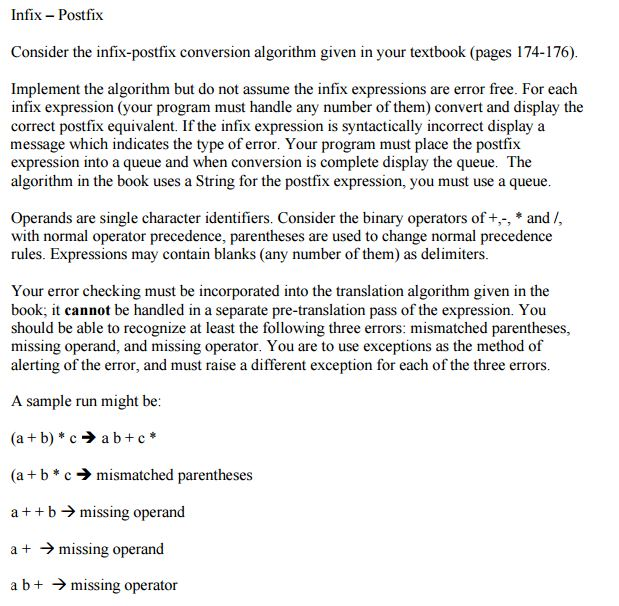Question
//Sorry I didnt include the code, it is to be coded in Java as well. I was unable to find the proper postfix method in

//Sorry I didnt include the code, it is to be coded in Java as well. I was unable to find the proper postfix method in my book.
import java.util.*;
public class InfixToPostfixParens { private static final String OPERATORS = "-+*/()"; private static final int[] PRECEDENCE = {1, 1, 2, 2, -1, -1}; private static final String PATTERN = "\\d+\\.\\d*|\\d+|" + "\\p{L}[\\p{L}\\p{N}]*" + "|[" + OPERATORS + "]"; private final Deque
public static String convert(String infix) throws SyntaxErrorException { InfixToPostfixParens infixToPostfixParens = new InfixToPostfixParens(); infixToPostfixParens.convertToPostfix(infix); return infixToPostfixParens.getPostfix(); }
private String getPostfix() { return postfix.toString(); }
private void convertToPostfix(String infix) throws SyntaxErrorException { try { String nextToken; Scanner scan = new Scanner(infix); while ((nextToken = scan.findInLine(pattern)) != null) { char firstChar = nextToken.charAt(0); if (Character.isLetter(firstChar) || Character.isDigit(firstChar)) { postfix.add(nextToken); } else if(isOperator(firstChar)) { processOperator(firstChar); } else { throw new SyntaxErrorException ("Unexpected Character Encountered: " + firstChar); } } while (!operatorStack.isEmpty()) { char op = operatorStack.pop(); if (op == '(') throw new SyntaxErrorException ("Unmatched opening parenthesis"); postfix.add(new Character(op).toString()); } return postfix.toString(); } catch (NoSuchElementException ex) { throw new SyntaxErrorException("Syntax Error: The stack is empty"); } } private void processOperator(char op) { if (operatorStack.isEmpty() || op == '(') { operatorStack.push(op); } else { char topOp = operatorStack.peek(); if (precedence(op) > precedence(topOp)) { operatorStack.push(op); } else { while (!operatorStack.isEmpty() && precedence(op) // top of stack operator precedence. if (op != ')') operatorStack.push(op); } } } public static class SyntaxErrorException extends Exception {
SyntaxErrorException(String message) { super(message); } } private static boolean isOperator(char ch) { return OPERATORS.indexOf(ch) != -1; }
private static int precedence(char op) { return PRECEDENCE[OPERATORS.indexOf(op)] ; }
}
Consider the infix-postfix conversion algorithm given in your textbook (pages 174-176). Implement the algorithm but do not assume the infix expressions are error free. For each infix expression (your program must handle any number of them) convert and display the correct postfix equivalent. If the infix expression is syntactically incorrect display a message which indicates the type of error. Your program must place the postfix expression into a queue and when conversion is complete display the queue. The algorithm in the book uses a String for the postfix expression, you must use a queue. Operands are single character identifiers. Consider the binary operators of +, -, * and/, with normal operator precedence, parentheses are used to change normal precedence rules. Expressions may contain blanks (any number of them) as delimiters. Your error checking must be incorporated into the translation algorithm given in the book; it cannot be handled in a separate pre-translation pass of the expression. You should be able to recognize at least the following three errors; mismatched parentheses, missing operand, and missing operator. You are to use exceptions as the method of alerting of the error, and must raise a different exception for each of the three errors. A sample run might be: (a + b)*c rightarrow ab + c* (a + b * c rightarrow mismatched parentheses a + + b rightarrow missing operand a + rightarrow missing operand a b + rightarrow missing operator
Step by Step Solution
There are 3 Steps involved in it
Step: 1

Get Instant Access to Expert-Tailored Solutions
See step-by-step solutions with expert insights and AI powered tools for academic success
Step: 2

Step: 3

Ace Your Homework with AI
Get the answers you need in no time with our AI-driven, step-by-step assistance
Get Started


